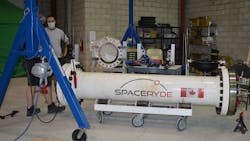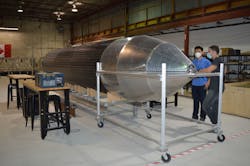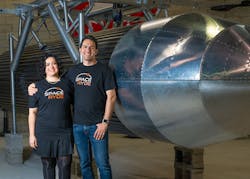Engineering Sustainable Rocket Launches from a Balloon
At a Glance:
- SpaceRyde, a Canadian startup, is building the future of space cargo transportation.
- SpaceRyde’s rocket system uses a stratospheric balloon to bypass 99% of the atmosphere without depositing black particles into the ozone.
- The upper stage of the rocket, called Black Bay, will remain in orbit to fulfil future tasks, including refueling, space junk removal and de-orbiting.
NASA’s announcement of three jump-start aerospace initiatives that would develop designs of space stations and other commercial space destinations signaled optimism for future projections to develop commercial activity in space.
Those initiatives—signed in December 2021 with Blue Origin in Kent, Wash., Nanoracks LLC of Houston and Northrop Grumman Systems Corporation in Dulles, Va.—are part of a broader plan intended to solidify U.S. commercial presence in low-Earth orbit by building the infrastructure to support development of independent space stations and to stimulate commercial activity.
Revenue generated from the global space market is expected to triple over the next 20 years to more than $1.1 trillion. As an investment theme, analysts at Morgan Stanley Research note that a burgeoning space economy is likely to impact a number of industries beyond Aerospace & Defense, including IT Hardware and Telecom sectors.
The combination of new technologies and the entry of private launch service providers is decreasing costs for launch and space hardware and is spawning a growing, quickly diversifying commercial startup scene.
READ MORE: Q&A: Clean up on the Space Aisle: Recovering Space Debris
By any standards across the globe, however, getting a rocket launch initiative off the ground requires a ton of resources, is bad for the environment and is costly. For companies based in Canada—which has about a 1.3% share of the global market and for the most part relies on other countries for rocket launches—crossing the threshold to join the commercial space race can be downright prohibitive.
That scenario could change with the ebullient innovations proposed by SpaceRyde, a rocket startup based in Concord, Ontario. Its intrepid founder, Sohrab Haghighat, has aspirations to realize a space transportation company that builds interplanetary logistics infrastructure.
Haghighat’s vision of a “rocket network” comes with big ambitions, beginning with SpaceRyde’s three-stage small satellite launcher targeted for Earth and lunar orbit missions. The startup’s objective is to build a network of smart rockets that will consume less fuel than conventional rockets, reduce the environmental impact and provide a cheaper, more efficient way to transport cargo to and from space.
Hoisted From a Balloon
Haghighat landed on the idea that using a stratospheric balloon to bypass the Earth’s atmosphere could help solve a host of problems, not the least of which was to provide the ESG (environmental, social and corporate governance) benefits he touts as the keystone to his mission.
The idea that a rocket could be floated through the Earth’s atmosphere via a stratospheric balloon filled with hydrogen gas is not new, pointed out Saharnaz Safari, SpaceRyde’s co-founder and COO, and Haghighat’s wife. The use of “rockoons” dates back to the 1950s when they were used to deploy suborbital atmospheric-research flights. The method was abandoned due to its unreliability.
SpaceRyde’s launch platform is deceivingly simple: A balloon system is designed to bypass 99% of the Earth’s atmosphere before the rocket launches from a rocket carrier and jets off to complete its mission of carrying cargo to its intended destination.
READ MORE: Postcards from the James Webb Space Telescope
Haghighat, who holds a PhD in aerospace, aeronautical and astronautical engineering from the University of Toronto, was under no illusion that launching a rocket from a balloon would require unique design modifications to the entire system, including an overhaul of the engines.
“From the get-go, the rocket starts operating in a vacuum condition,” Haghighat explained. “With that comes vacuum-optimized engines. The performance of the rocket is improved. And since the rocket does not deal with high-speed travel through dense layers of the atmosphere, stress on the structure is reduced.
“In a ground-launch rocket, the vacuum efficiency is only present in the upper stage,” he continued. “For SpaceRyde’s rocket it is present and available to all stages and results in a generally more efficient rocket. So, not only does this become a solution that addresses atmospheric and environmental concerns, it also brings a lot of benefits with it.”
Path to Orbit
The cumulative effects of light-weighting the vessel are integral to the benefits. “We are not concerned with fast travel through dense layers of the atmosphere,” said Haghighat. “You don’t have to deal with loading on the structure. You don’t have to deal with the concept of Max Q or aerodynamic loading on the structure of the rocket. This means that the structure can be simplified. As a result, it becomes lighter.”
Max Q is shorthand for maximum dynamic pressure. It is the point at which the shuttle has reached the air pressure limit and undergoes maximum mechanical stress while passing through the atmosphere.
Since the balloon lifts the rocket through the atmosphere, drag and gravitational losses are close to zero. “Gravitational loss is something you incur when you are flying against gravity,” explained Haghighat. “Because we launch at a very shallow path angle—pretty much horizontally—we incur very little gravitational loss. The rocket has to provide less energy to bring the payload to orbital speed. That means the rocket gets smaller.”
READ MORE: Satellite Trash Collectors: Policies for Space Debris
Although the balloon’s ascent through the atmosphere takes about an hour, the actual launch can be as quick as 10 to 15 min. “With a balloon, you’re peacefully bringing the rocket up to three times as high as planes fly,” explained Safari. “And once you get to that high altitude, where it’s basically near vacuum conditions and the atmosphere is gone, that’s when you launch the rocket. It doesn’t create noise like rocket launchers do, it doesn’t create emissions like rocket launchers, nor does it deposit black particles into the ozone layer like other rocket launchers do.”
Flying Spider, Hidden AI
The rocket carrier is primarily an aluminum frame that attaches to the balloon. It was dubbed “Flying Spider” after the behavior of small spiders that release gossamer threads to catch the wind and become airborne across long distances. For Safari, the name is fitting for a structure she considers to be “the heart of the operation.”
The first iteration of the rocket carrier was significantly over-designed and sub-optimal for scaling the rocket. It has since been reengineered to accommodate bigger rockets with payloads up to 150 kg.
The rocket carrier is reclaimable, too, as engineers are able to safely steer the rocket carrier back to Earth—with the rocket aboard. “We don’t know exactly where the balloon will take the rocket—the initial location is unknown,” Safari said. “The carrier points the rocket, stabilizes it and becomes the launchpad midair.”
An electronic circuit box affixed to the carrier houses an array of sensors, proprietary software and microcomputers, all of which control the trajectory of the rocket from the launch position.
Haghighat said the entire navigation system was designed with simplicity in mind, as it combines off-the-shelf components, GPS and other sensors with software and algorithms. “We take advantage of advanced filtering and data fusion algorithms to come up with a navigation system that is not on par but better than what is offered by speed-rated legacy hardware, at a fraction of the cost,” he explained.
Haghighat comes by his navigation knowledge honestly. He previously worked for Cruise, an autonomous car technology company, where he pedaled his academic knowledge of working with software algorithms toward becoming an expert on navigation and control systems that move things (cars and trains) autonomously. “When I was doing my PhD, I showed that when aircrafts take advantage of active control systems, they can increase fuel efficiency, or they can increase endurance by up to 21%,” he recalled.
Propulsion Engineering
Relatively small by industry standards, SpaceRyde’s three-stage satellite launcher, named Ryder, is equipped with vacuum-optimized gimbaling hybrid engines that can provide significantly higher performance than rockets optimized to lift off the ground.
In its simplest form, a hybrid-propellant rocket system is composed of a solid propellant (fuel) housed in a combustion chamber and a liquid propellant (oxidizer). The two fuels are stored separately, but when the two fuels are combined, a strong exothermic reaction produces hot gas through a nozzle to propel the rocket.
SpaceRyde’s Grolar engine is the only hybrid engine in the world with nozzle gimbaling capability, according to Haghighat. His team employed stress testing methods and analyses to reveal an optimized design that improved the structural integrity, as well as weight and manufacturability characteristics.
READ MORE: Next Frontier: Space Disposal Systems and Satellite Servicing
In gimbaled systems, the nozzle can be swiveled to control the direction of thrust or the trajectory the rocket takes. The combustion chamber in a typical liquid engine is relatively small, as it is optimized to move the whole engine. “In contrast, the combustion chambers in hybrid engines are big, making it impossible to move the combustion chamber. It would require huge actuators, which adds to the weight, along with other requirements that are just not worth the effort.”
The “trick” was to move the nozzle. “In order to do so, you need a flexible seal that joins the nozzle to the combustion chamber,” Haghighat explained. “It provides the means to gimbal the nozzle, while simultaneously sustaining the temperature and pressure of combustion and making sure that it is providing a seal.”
Deep Space Logistics
With rapidly growing and changing public and private space endeavors come new sustainability questions. One aspect is the space junk, or debris, floating in lower orbit. Ranging from paint flakes and discarded hardware to rocket stages and defunct satellites, this detritus is the result of launching objects from Earth.
Space junk is not motionless and pose a risk to other satellites in low-Earth orbit. Debris orbits the Earth at speeds of about 15,700 miles per hour. (That’s more than 10 times faster than the speed of a bullet.)
In September 2022 the Federal Communications Commission (FCC) issued new rules requiring satellite operators in low-Earth orbit to dispose of their satellites within five years of completing their missions.
Haghighat’s commitment to designing for future generations who will inherit the challenges of today is proving to be pre-emptive in heeding such regulatory realities. Ryder’s upper stage (known as Black Bay) was purposefully designed to be reusable and multipurpose. “Once it completes the initial mission in space, it can remain operational and be put into other tasks and missions, such as lifting another satellite into higher orbit, or de-orbiting a malfunctioning satellite, or it can be refueled and transport something to the lunar orbit,” Haghighat said.
“Not only are we are not contributing to space junk, but we are also over time building a network of rockets that are going to continuously go back and forth between the Earth and the Moon,” he said. “That is the backbone of space transportation.”
Cost to Innovate
In spite of all the advancements we see and hear about, technological progress in space is significantly slower than what we experience on the planet. Addressing the availability, affordability and frequency of space missions is one way to bridge the gap, Haghighat argued.
To that end, added Safari, the opportunities generated from going above the atmosphere to launch the rocket and developing multipurpose, reusable rocket systems can provide enormous cost advantages.
If SpaceRyde is to succeed at its business case, it will need to be both realistic and practical. While reducing the rocket’s diameter reduces drag, the size and mass reduction dictates the optimal payload. But rather than view this as a negative constraint, Haghighat and Safari characterized it as an opportunity to focus on customers with smaller payloads, especially those that would otherwise be deterred by narrow launch schedules. The company has pegged its target price at $250,000 for a payload of 150 kg. “We’re looking at an order of magnitude in driving down the cost of the launch of a rocket,” Safari said.
By Morgan Stanley estimates, the cost to launch a satellite has declined from $200 million to about $60 million as a result of reusable rockets, with a potential drop to as low as $5 million. Satellite mass production could shrink costs further from $500 million per satellite to $500,000.
SpaceRyde’s success will be a multi-decade endeavor and the payoff will ultimately depend on scalability. To date, the company has raised about $10 million, with backing from both equity investors, including YCombinator, and government grants from the Canadian Space Agency, National Research Council Canada and Sustainable Development Technology Canada.
In November 2022, SpaceRyde shook hands on a deal to deliver on multiple launch agreements with ISILAUNCH, a Netherlands-based CubeSat and small satellite solutions provider. The MLA signified SpaceRyde’s readiness to offer customizable rockets geared for precise orbits with price points starting at $250,000.
“Innovation is always risky,” said Haghighat. “But when we can do that 10 times, or 20 times a year, then we come up with creative solutions that may or may not pan out. But through doing that, we come up with something that creates a paradigm shift. The fact that access is not yet on demand is what stops innovation or slows down innovation in space significantly.”
Add to the space equation the moonshot demand to send polluting industries to outer space, and Hagighat remains unfazed. “Those factories would require tools, raw materials, and they need the product to be brought back to the planet,” he said. “SpaceRyde is building the infrastructure to support this demand and wants to do so sustainably.”
About the Author

Rehana Begg
Editor-in-Chief, Machine Design
As Machine Design’s content lead, Rehana Begg is tasked with elevating the voice of the design and multi-disciplinary engineer in the face of digital transformation and engineering innovation. Begg has more than 24 years of editorial experience and has spent the past decade in the trenches of industrial manufacturing, focusing on new technologies, manufacturing innovation and business. Her B2B career has taken her from corporate boardrooms to plant floors and underground mining stopes, covering everything from automation & IIoT, robotics, mechanical design and additive manufacturing to plant operations, maintenance, reliability and continuous improvement. Begg holds an MBA, a Master of Journalism degree, and a BA (Hons.) in Political Science. She is committed to lifelong learning and feeds her passion for innovation in publishing, transparent science and clear communication by attending relevant conferences and seminars/workshops.
Follow Rehana Begg via the following social media handles:
X: @rehanabegg
LinkedIn: @rehanabegg and @MachineDesign




